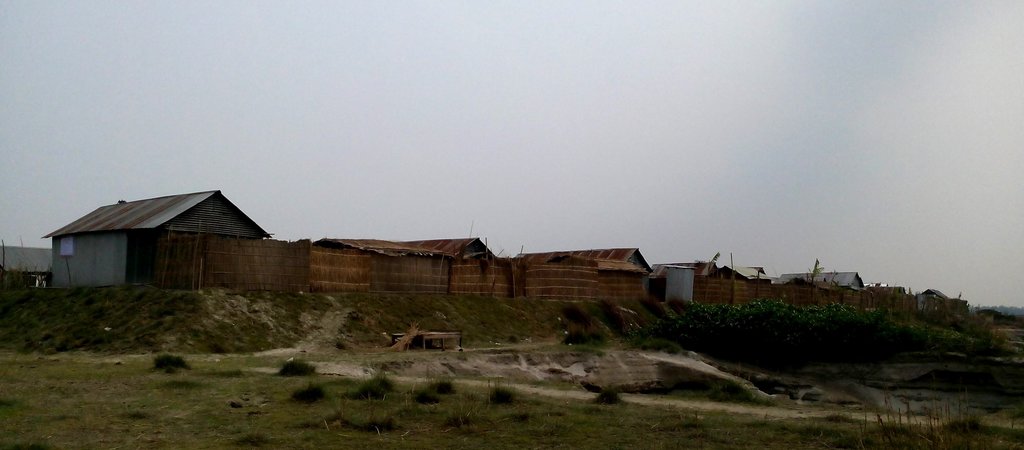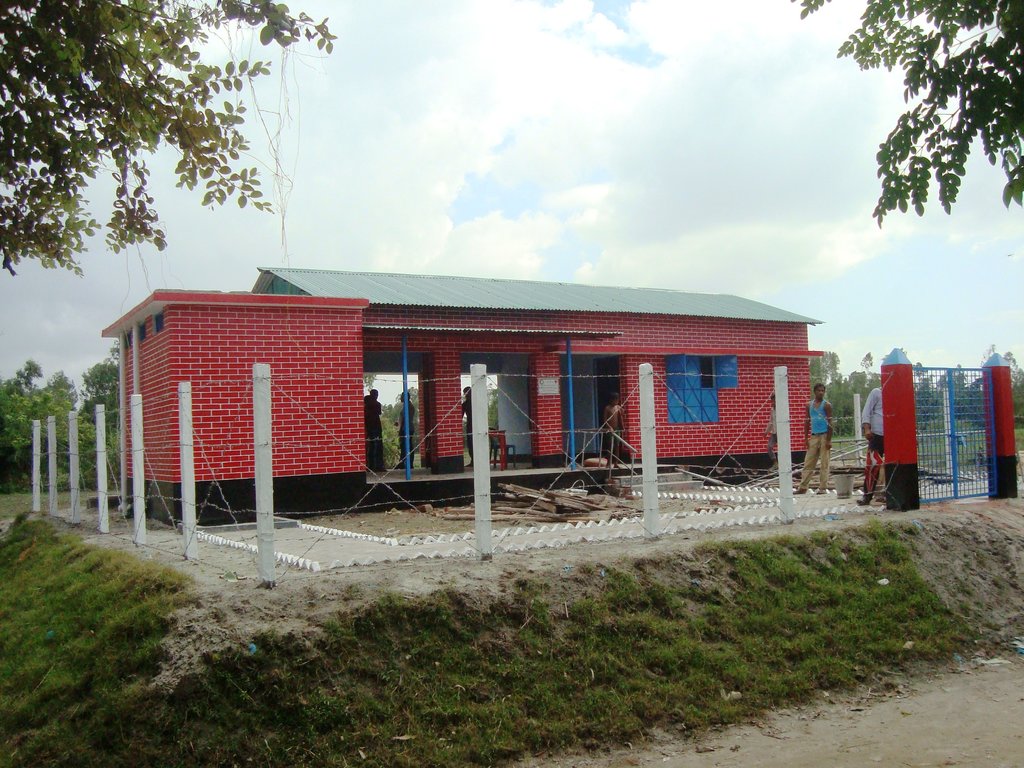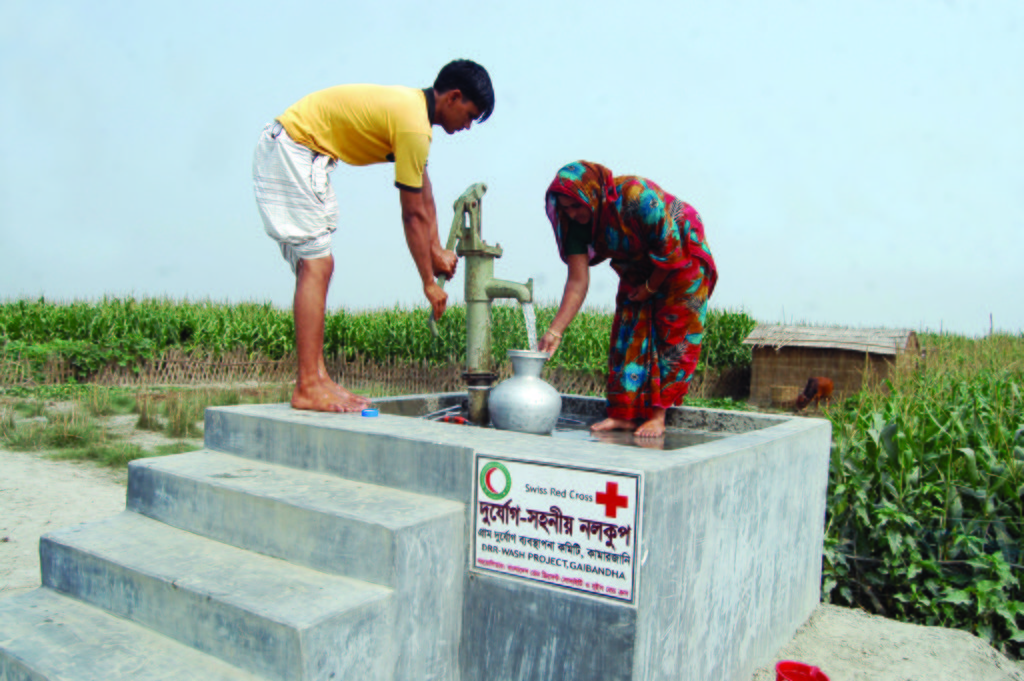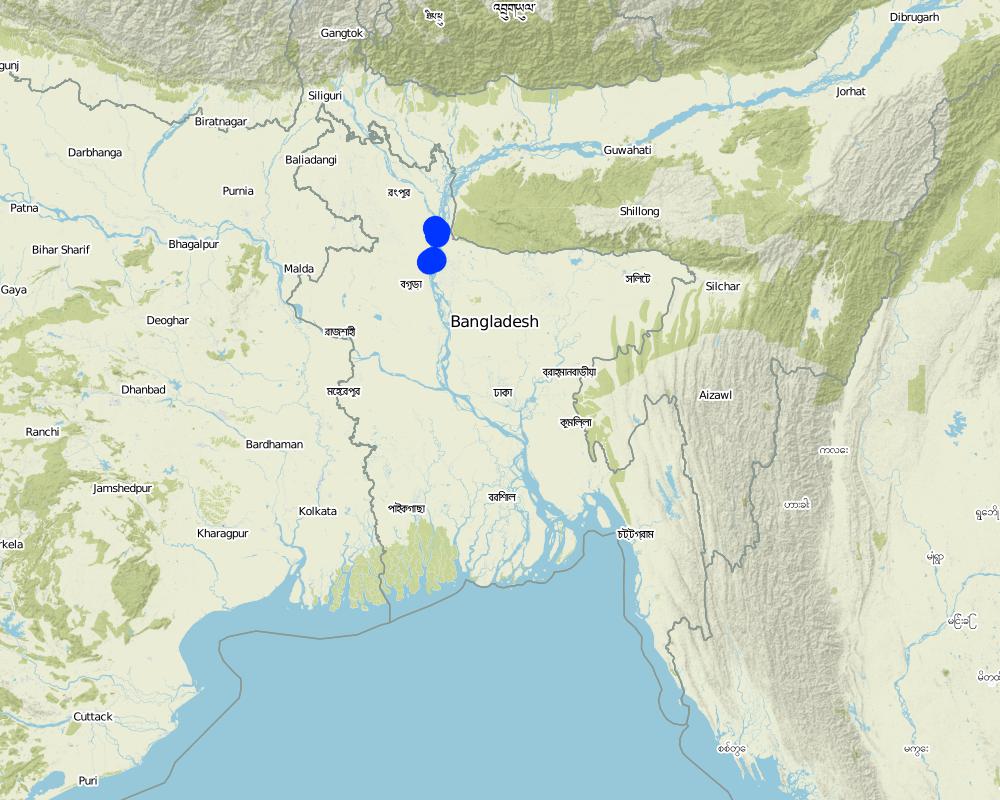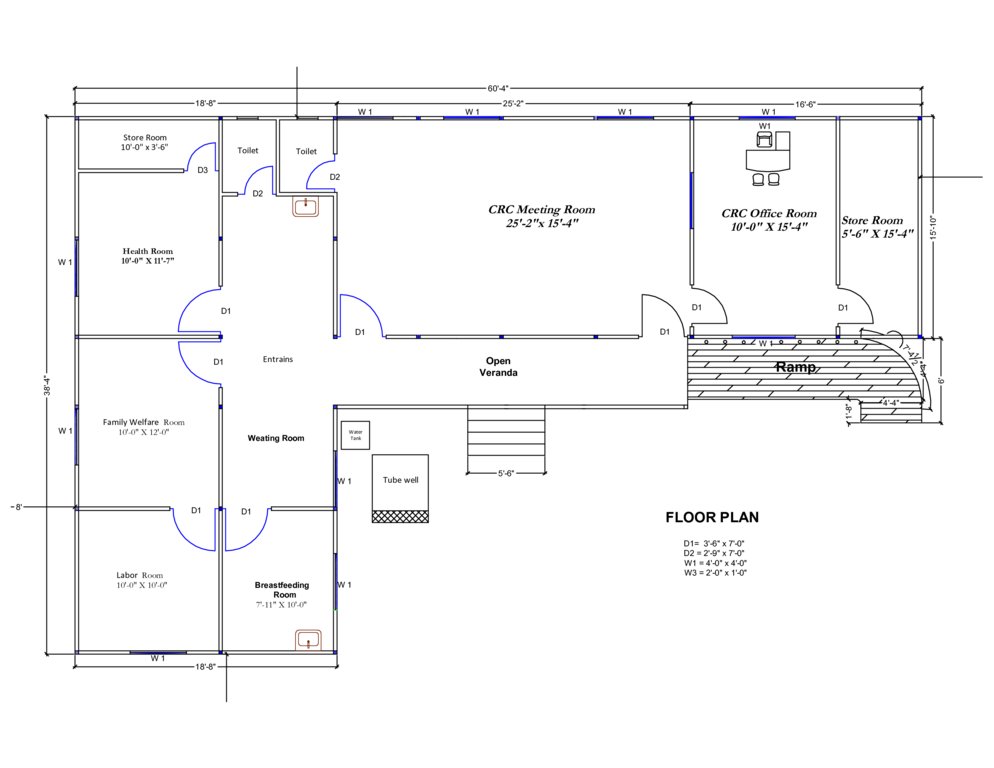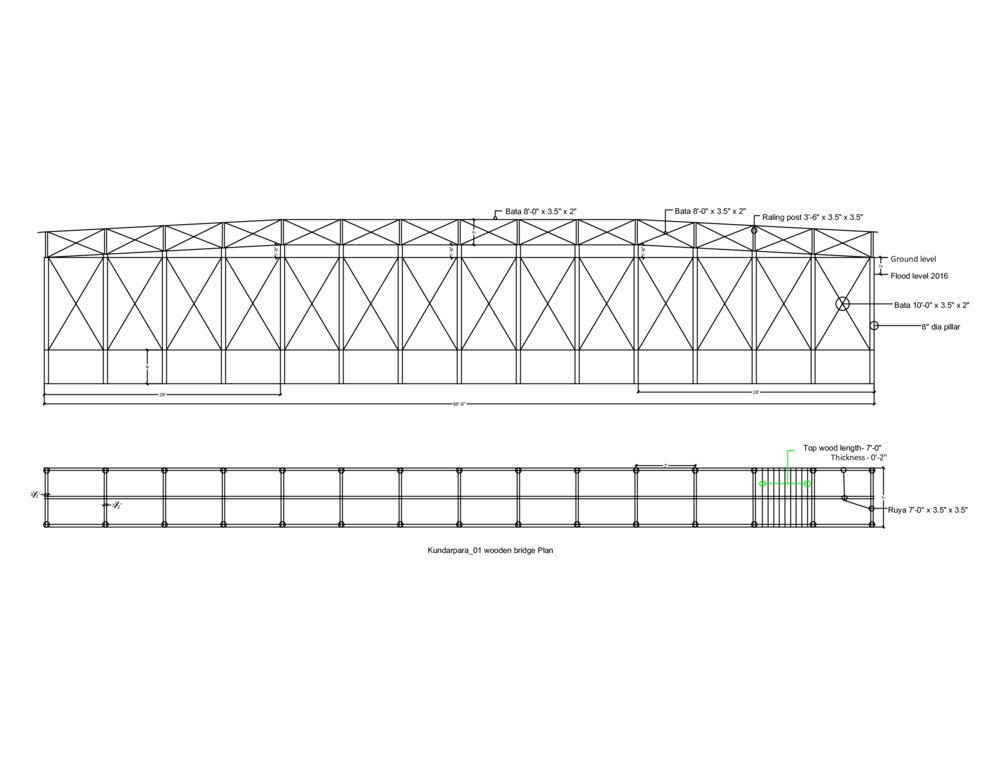Emergency infrastructure including shelter and linked transport infrastructure [Bangladesh]
- Creation:
- Update:
- Compiler: TUHIN SAMADDAR
- Editor: Anton Jöhr
- Reviewers: Alexandra Gavilano, Hanspeter Liniger, Nicole Harari
দুর্যোগ সহনশীন অবকাঠামো উন্নয়ন (Durjog-shahonshil abokathamo unnayon)
technologies_664 - Bangladesh
- Full summary as PDF
- Full summary as PDF for print
- Full summary in the browser
- Full summary (unformatted)
- Emergency infrastructure, shelter and access: Maart 28, 2017 (inactive)
- Emergency infrastructure including shelter and linked transport infrastructure: Aug. 2, 2017 (inactive)
- Emergency infrastructure including shelter and linked transport infrastructure: Nov. 10, 2017 (inactive)
- Emergency infrastructure including shelter and linked transport infrastructure: Maart 5, 2019 (public)
View sections
Expand all Collapse all1. General information
1.2 Contact details of resource persons and institutions involved in the assessment and documentation of the Technology
Key resource person(s)
Project Staff:
Mustafa Golam
Bangladesh Red Crescent Society
Bangladesh
Project Staff:
Razzak Abdur
Bangladesh Red Crescent Society
Bangladesh
Project Staff:
Islam Saiful
Bangladesh Red Crescent Society
Bangladesh
Name of project which facilitated the documentation/ evaluation of the Technology (if relevant)
Book project: where people and their land are safer - A Compendium of Good Practices in Disaster Risk Reduction (DRR) (where people and their land are safer)Name of the institution(s) which facilitated the documentation/ evaluation of the Technology (if relevant)
Swiss Red Cross (Swiss Red Cross) - Switzerland1.3 Conditions regarding the use of data documented through WOCAT
The compiler and key resource person(s) accept the conditions regarding the use of data documented through WOCAT:
Ja
1.4 Declaration on sustainability of the described Technology
Is the Technology described here problematic with regard to land degradation, so that it cannot be declared a sustainable land management technology?
Nee
Comments:
The technology presented has no direct bearing on land degradation.
1.5 Reference to Questionnaire(s) on SLM Approaches (documented using WOCAT)
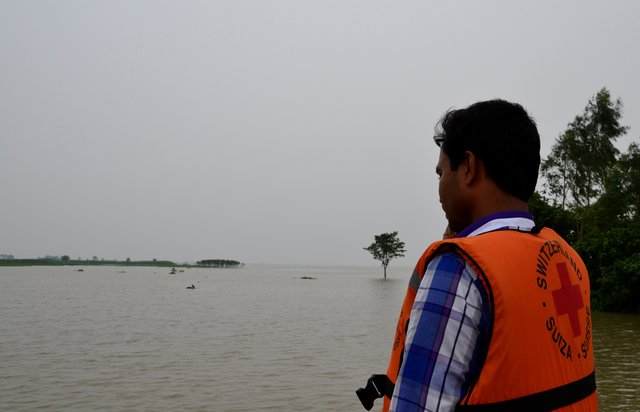
Early Warning Message Dissemination [Bangladesh]
An effective system for dissemination of early warning messages was established among the vulnerable communities in Chars (riverine sandy islands) of Gaibandha district, Bangladesh, in order to strengthen their coping mechanisms and reduce loss and damage caused by floods.
- Compiler: TUHIN SAMADDAR
2. Description of the SLM Technology
2.1 Short description of the Technology
Definition of the Technology:
Emergency infrastructure including shelter and linked transport infrastructure, consists in establishing specific flood shelters (for people and animals) including flood-proof collective water sources and communication infrastructure as well as health and school facilities that may serve at the same time as emergency shelters during floods.
2.2 Detailed description of the Technology
Description:
The technology applies to the specific context of the ‘Char’ land in Bangladesh, characterised as riverine sandy Islands along the Jamuna River. More than 80% of the land in the intervention area can be classified as 'Char' and is inhabited by 60% of the population served by the project. Every year, especially during floods, the rivers deposit huge amount of silt sediment that makes the land fertile. At the same time, river action washes away some portion of the 'Char' which at times can be quite large and has a strong impact on people's lives and livelihoods. Before the intervention, people living on 'Char' land depended on their traditional early warning mechanisms and were frequently surprised by floods that destroyed their crops and put their lives in danger. Due to recurring floods, people didn’t have the means to improve their built environment. The 'Char' land is furthermore characterised by its lack of public infrastructure and remoteness to public services.
The technology consists of setting up an emergency infrastructure and ensuring community access to these infrastructures during times of floods. It has to be understood in close interrelation with the approach of setting up an early warning system. The emergency infrastructure includes specific flood shelters (for people and animals), flood-proof collective water sources and sanitation systems, transport infrastructure such as foot bridges and elevated rural roads, as well as flood-proof health and school facilities that also serve as emergency shelters during floods. The flood shelters are built on a raised bed of soil and located at sites selected by the communities that are relatively better protected from flood and river erosion within the 'Chars'. The purpose of the technology is to ensure safety of life and protection of assets during times of emergency and also to mitigate sufferings related to floods. The flood shelter is an elevated plane land which is on an average 220 square feet by size and at least five feet high from the existing ground level. The site is selected by the community and should be connected through an elevated road to the nearest community. This arrangement helps people to get easy access during times of floods. The shelter has collective hygienic latrine facilities and safe water sources. People generally dismantle their housing while evacuating and reinstall it on the flood shelter.
The major activities include facilitating the development of community-led risk reduction action plans and their implementation through community participation and engagement of local governance institutions. This includes maintenance of the built infrastructure as the joint responsibility of the community and the local government. Land use, especially sowing and harvesting, is increasingly linked to flood related forecasting measures which has led to significant adaptation in the timing of farming activities. This coupled with the creation and access to emergency infrastructure allows for a relatively safe and healthy living. The adopted technology and approach has led to adapted livelihoods, reduced health costs and increased income. The technology has furthermore led to mainstreaming disaster risk management in policies and approach of local government institutions. Increasingly the local government’s cash and food for work programmes are targeting establishment and/or reinforcement of emergency infrastructure that can cater to larger population. Increased investments are made especially towards flood shelters and improving communication and access to emergency infrastructure. Since the technology is based on local knowledge and has been developed in consultation with the involved communities, it is generally well accepted with a fair degree of ownership and involvement. However, parts of the region are also prone to river erosion and this has a destructive impact on built infrastructures. The technology does not assure any safeguard against this form of uncertain river action.
2.3 Photos of the Technology
General remarks regarding photos:
Glimpse of few technologies that served as emergency infrastructure, shelter and access to health and water and sanitation facilities.
2.5 Country/ region/ locations where the Technology has been applied and which are covered by this assessment
Country:
Bangladesh
Region/ State/ Province:
North-Bengal
Further specification of location:
Kamarjani and Mollar Char Union (i.e. municipality) in Sadar Upazila and Haldia Union in Shaghata Upazila of Gaibandha District
Specify the spread of the Technology:
- evenly spread over an area
If precise area is not known, indicate approximate area covered:
- 1-10 km2
Comments:
Since the disaster resilient infrastructure set up by the project is installed at a huge number of sites (as indicated in the description above), only a sample of the various emergency infrastructures are indicated on the map above (If needed a comprehensive GPS reading of all infrastructure built by the project can be provided separately).
Though emergency infrastructures are built at specific sites, their use and benefits are evenly spread over an expanded area.
Map
×2.6 Date of implementation
Indicate year of implementation:
2014
If precise year is not known, indicate approximate date:
- less than 10 years ago (recently)
2.7 Introduction of the Technology
Specify how the Technology was introduced:
- as part of a traditional system (> 50 years)
- through projects/ external interventions
Comments (type of project, etc.):
The technology has elements of traditional practice (raised plinths for flood protection) and project promoted interventions (emergency shelter and access infrastructure).
3. Classification of the SLM Technology
3.1 Main purpose(s) of the Technology
- reduce risk of disasters
- create beneficial economic impact
- create beneficial social impact
3.2 Current land use type(s) where the Technology is applied

Cropland
- Annual cropping
- Perennial (non-woody) cropping
Annual cropping - Specify crops:
- cereals - maize
- cereals - other
- cereals - rice (wetland)
- cereals - wheat (winter)
- legumes and pulses - other
- root/tuber crops - sweet potatoes, yams, taro/cocoyam, other
- vegetables - leafy vegetables (salads, cabbage, spinach, other)
- Kharif and Rabi (Cereals)
Perennial (non-woody) cropping - Specify crops:
- medicinal, aromatic, pesticidal plants - perennial
Number of growing seasons per year:
- 3
Specify:
Kharif (monsoon crop), Rabi (winter crop), and Summer/pre-monsoon crop

Grazing land
- Every household have at least a pair or more of livestock.
Animal type:
- buffalo
- cattle - non-dairy beef
- cattle - non-dairy working
- goats
- mules and asses
- sheep
Is integrated crop-livestock management practiced?
Nee

Settlements, infrastructure
- Settlements, buildings
- Traffic: roads, railways
Comments:
Despite the lack of public infrastructure and services and being exposed to natural hazards people tend to prefer to live in the 'Char' as it brings significant economic benefits for them: crops grow rapidly and abundantly with significantly lower input costs than on the mainland.
Cow, buffalo, goat, lamb and donkey are very common in the area. People rear these for cultivation, transportation and for having meat. Every household have at least a pair or more of livestock.
3.4 Water supply
Water supply for the land on which the Technology is applied:
- mixed rainfed-irrigated
Comments:
Water supply for the land comprises a mix of rainfed, irrigated and post flooding sources.
3.5 SLM group to which the Technology belongs
- Emergency infrastructure, shelter and linked transportation infrastructure
3.6 SLM measures comprising the Technology

structural measures
- S9: Shelters for plants and animals
- S11: Others

management measures
- M4: Major change in timing of activities
Comments:
In addition to the structural and management measures described above, the technology involves additional elements such as flood-proof collective water supply and sanitation systems and communication infrastructure.
3.7 Main types of land degradation addressed by the Technology

soil erosion by water
- Wr: riverbank erosion
- Wo: offsite degradation effects
Comments:
N/A
3.8 Prevention, reduction, or restoration of land degradation
Specify the goal of the Technology with regard to land degradation:
- adapt to land degradation
Comments:
NA
4. Technical specifications, implementation activities, inputs, and costs
4.1 Technical drawing of the Technology
Technical specifications (related to technical drawing):
The built structural mitigation options have following technical specification:
1. Flood shelter: Dimension: Length-220' x Width-220' x Height- 5.5', Slope: 1:1.5, Capacity: 350 families, Construction material used: soil and turfing (grass)
2. Raised school compound: Dimension: Length-112' x Width-75' x Height- 5.5', Slope: 1:1.5, Capacity: 540 person, Construction material used: soil and turfing (grass)
3. Community Resource Centre and Community Clinic (CRC-CC): Dimension: Length-60' x Width-38' x Height- 5.6', Slope: 1:1.5, Capacity: 1500 families from 5 villages, Construction material used: soil and grass plantation, bricks, sand, cement, rod, iron angel and CGI sheet.
4. Disaster resilient tube well: Dimension: Length-5' 10" x Width-5' x Height- 3', Boring: 100 feet, Capacity: 200 families, Construction material used: bricks, sand, cement, rod, tube well head, pvc pipe, cylinder, piston rod etc. Vertical intervals: 2 in each village.
5. Concrete platform for (existing) tube well: Dimension: Length-4' 10" x Width-4' x Height- 1', Capacity: 100 families, Construction material used: bricks, sand, cement, pvc pipe
6. Wooden bridge: Dimension: Length-99' x Width-7' x Height- 12', Slope: 1:1.5, Capacity: 900 families approximately, Construction material used: wood, nails, tar, soil and grass plantation
7. Road construction/repair: Dimension: Length-925' x Width-12' x Height- 3' (from existing level), Slope: 1:1.5, Capacity: 3 villages (approx:1000 families), Construction material used: soil and turfing (grass).
Author:
Abdur Razzak
Date:
17/10/2016
4.2 General information regarding the calculation of inputs and costs
Specify how costs and inputs were calculated:
- per Technology unit
Specify unit:
flood shelter, raised school compound, disaster resilient tube well, concrete platform for (existing) tube well, wooden bridge, road construction/repair
Specify dimensions of unit (if relevant):
road: per meter
other/ national currency (specify):
Bangladeshi Taka (BDT)
If relevant, indicate exchange rate from USD to local currency (e.g. 1 USD = 79.9 Brazilian Real): 1 USD =:
79.0
Indicate average wage cost of hired labour per day:
350 BDT
4.3 Establishment activities
| Activity | Timing (season) | |
|---|---|---|
| 1. | Construction of Flood Shelter | During dry season |
| 2. | Raising school compound | During dry season |
| 3. | Construction of Community Resource Center (CRC) | During dry season |
| 4. | Installation of disaster resilient tube well | During dry season |
| 5. | Construction of concrete platform for (existing) tube well | During dry season |
| 6. | Construction of wooden bridge | During dry season |
| 7. | Road construction above flood level | During dry season |
Comments:
All activities are structural in nature and can be undertaken efficiently only in dry season.
4.4 Costs and inputs needed for establishment
| Specify input | Unit | Quantity | Costs per Unit | Total costs per input | % of costs borne by land users | |
|---|---|---|---|---|---|---|
| Labour | Flood shelter: earth work | m3 | 8000.0 | 64.0 | 512000.0 | 10.0 |
| Labour | CRC: earth work | m3 | 53.0 | 138.0 | 7314.0 | 10.0 |
| Labour | CRC: sand filling | m3 | 302.0 | 99.0 | 29898.0 | 10.0 |
| Labour | Raised school compound: earth work | m3 | 1790.0 | 64.0 | 114560.0 | 10.0 |
| Plant material | Flood shelter: grass plantation (turfing) | m2 | 4620.0 | 13.0 | 60060.0 | 10.0 |
| Plant material | Flood shelter: seedlings | piece | 20.0 | 53.0 | 1060.0 | 10.0 |
| Plant material | CRC: grass plantation (turfing) | m2 | 3890.0 | 13.0 | 50570.0 | 10.0 |
| Plant material | CRC: seedlings | piece | 50.0 | 53.0 | 2650.0 | 10.0 |
| Plant material | Raised school compound: grass plantation (turfing) | m2 | 1390.0 | 13.0 | 18070.0 | 10.0 |
| Plant material | Raised school compound: seedlings | piece | 40.0 | 53.0 | 2120.0 | 10.0 |
| Construction material | CRC: roof truss | kg | 4375.0 | 100.0 | 437500.0 | |
| Construction material | CRC: grill and iron work | m2 | 88.0 | 2091.0 | 184008.0 | |
| Construction material | CRC: gypsum board | m2 | 478.0 | 922.0 | 440716.0 | |
| Construction material | CRC: RCC work | m3 | 2.9 | 19557.0 | 56715.3 | |
| Construction material | CRC: deformed bar | kg | 397.0 | 85.0 | 33745.0 | |
| Construction material | CRC: boundary fencing | m2 | 184.0 | 440.0 | 80960.0 | |
| Construction material | CRC: brick work | m3 | 44.0 | 5515.0 | 242660.0 | |
| Other | CRC: electric ware and solar panel | lumpsum | 1.0 | 73000.0 | 73000.0 | |
| Other | CRC: water supply | lumpusm | 1.0 | 66150.0 | 66150.0 | |
| Other | CRC: transportation | lumpsum | 1.0 | 89000.0 | 89000.0 | |
| Total costs for establishment of the Technology | 2502756.3 | |||||
| Total costs for establishment of the Technology in USD | 31680.46 | |||||
If land user bore less than 100% of costs, indicate who covered the remaining costs:
10% of all construction cost (except community resource center) is borne by the user. Another 15% is provided by the local government bodies. The remaining 75% is subsidised by the project.
Comments:
Defining costs of establishment is bit tricky as the measures differ in size and number, costs vary from one village to another depending on the geographical location. However, average costs of the measures further to those highligted in the table are given below:
Disaster resilient tube well: labour (mason) 3'000, equipment (drilling charge) 1800, construction material (bricks, cement, sand, iron rod, PVC pipe, cylinder, GI pipe, tubewell head) 23'250, transportation 2'650, total unit costs (BDT) 30'700
Concrete platform for (existing) tube well : labour (mason) 600, construction material (bricks, cement, sand) 2'450, other (Transportation, waste water disposal) 1650, total unit costs (BDT) 4'700
Wooden bridge: labour (mason, mason assitant, painting assistant, earthwork) 30'000, plant material (grass plantation) 12'500, equipment (painting brush etc.) 1'000, construction material (timber, nails, tar, tarpin oil, paint) 260'000, Transportation 30'000, total unit costs (BDT) 333'500
Road construction/repair: labour (earthwork) 102'500, plant material (grass plantation/turfing), 12'500, total unit costs (BDT) 115'000
4.5 Maintenance/ recurrent activities
| Activity | Timing/ frequency | |
|---|---|---|
| 1. | Construction of Flood Shelter | During dry season |
| 2. | Raising school compound | During dry season |
| 3. | Construction of Community Resource Center (CRC) | During dry season |
| 4. | Installation of disaster resilient tube well | During dry season |
| 5. | Construction of concrete platform ror (existing) tube well | During dry season |
| 6. | Construction of wooden bridge | During dry season |
| 7. | Road construction above flood level | During dry season |
Comments:
Due to the softness of the sandy soil and the annual inundation, every measure requires considerable maintenance. The flooding generally washes out sands and decays the foundation of the structure. If maintenance is done in regular intervals, the entire structure remains functional. Also, grass needs to be frequently replanted as it dries up during the dry season.
The users and the local government (Union Disaster Management Committee) are mainly responsible for maintenance of all built assets and structures including the Community Resource Center. The relevant operation/repair and maintenance training has been provided by the project.. Maintenance manuals and guidelines have been developed and disseminated. Also, repair and maintenance equipment has been provided to cadre of users/caretakers trained in repair/maintenance work.
4.6 Costs and inputs needed for maintenance/ recurrent activities (per year)
| Specify input | Unit | Quantity | Costs per Unit | Total costs per input | % of costs borne by land users | |
|---|---|---|---|---|---|---|
| Labour | Earthwork | m3 | 80.0 | 63.0 | 5040.0 | 10.0 |
| Labour | Sand bag filling | piece | 50.0 | 15.0 | 750.0 | 10.0 |
| Labour | Pipe fitting | piece | 2.0 | 300.0 | 600.0 | 10.0 |
| Labour | Mason | lumpsum | 1.0 | 500.0 | 500.0 | 10.0 |
| Plant material | Grass plantation (turfing) | m2 | 85.0 | 13.0 | 1105.0 | 10.0 |
| Plant material | Seedlings | piece | 15.0 | 53.0 | 795.0 | 10.0 |
| Construction material | Plastic bag | piece | 50.0 | 10.0 | 500.0 | 10.0 |
| Construction material | PVC pipe | m | 15.0 | 120.0 | 1800.0 | 10.0 |
| Construction material | Polythene pipe | kg | 5.0 | 160.0 | 800.0 | 10.0 |
| Construction material | Ciment | bag | 0.5 | 540.0 | 270.0 | 10.0 |
| Construction material | Sand | ft3 | 5.0 | 18.0 | 90.0 | 10.0 |
| Construction material | Caping socket | piece | 2.0 | 35.0 | 70.0 | 10.0 |
| Construction material | Tape etc. | lumpsum | 1.0 | 250.0 | 250.0 | 10.0 |
| Total costs for maintenance of the Technology | 12570.0 | |||||
| Total costs for maintenance of the Technology in USD | 159.11 | |||||
If land user bore less than 100% of costs, indicate who covered the remaining costs:
Maintenance costs are to date (2017) distributed as construction (10% by the users, 15% by the local government). A cost transfer scheme to the users and local government for maintenance is developped to be applied in the follow-up phase.
Comments:
Again, defining costs of maintenance is also not easy as the measures differ in size and number. Average costs of the measures, further to those for flood shelter including disaster resilient tube well as highligted in the table, are given below:
Raised school compound: labour (earth work and sand bag filling) 7'800, plant material (grass plantation) 1'000, construction material (plastic bag, rope) 500, total unit maintenance costs (BDT) 9'300
Community resource Center (CRC): labour 1'200, plant material (grass plantation, seedlings) 10'500, Transportation 1'000, total unit maintenance costs (BDT) 12'700
Concrete platform for (existing) tube well : labour (mason) 500, construction material (bricks, cement, sand) 600, total unit maintenance costs (BDT) 1'100
Wooden bridge: labour (earthwork) 2'500, plant material (grass plantation) 3'000, construction material (plastic bag, rope) 2'000, total unit maintenance costs (BDT) 7'500
Road construction/repair: labour (earthwork) 10'000, plant material (grass plantation/turfing), 1'500, construction material (plastic bag, rope) 500, total unit maintenance costs (BDT) 12'000
4.7 Most important factors affecting the costs
Describe the most determinate factors affecting the costs:
Transportation of raw material from the mainland to the sites on the 'Char' Islands varies across seasons. In the dry season it is much higher compared to monsoon as the delivery of material is easier in the latter due to extended river outreach.
5. Natural and human environment
5.1 Climate
Annual rainfall
- < 250 mm
- 251-500 mm
- 501-750 mm
- 751-1,000 mm
- 1,001-1,500 mm
- 1,501-2,000 mm
- 2,001-3,000 mm
- 3,001-4,000 mm
- > 4,000 mm
Specify average annual rainfall (if known), in mm:
2134.80
Specifications/ comments on rainfall:
Rainy season: April- October
Occurrence of heavy rain: June-July
Length of dry period: November-March
Indicate the name of the reference meteorological station considered:
18 Gaibandha Sadar, Gaibandha
Agro-climatic zone
- humid
Tropical humid climatic zone.
Temperature: maximum 33.5°C, minimum 10.5°C
5.2 Topography
Slopes on average:
- flat (0-2%)
- gentle (3-5%)
- moderate (6-10%)
- rolling (11-15%)
- hilly (16-30%)
- steep (31-60%)
- very steep (>60%)
Landforms:
- plateau/plains
- ridges
- mountain slopes
- hill slopes
- footslopes
- valley floors
Altitudinal zone:
- 0-100 m a.s.l.
- 101-500 m a.s.l.
- 501-1,000 m a.s.l.
- 1,001-1,500 m a.s.l.
- 1,501-2,000 m a.s.l.
- 2,001-2,500 m a.s.l.
- 2,501-3,000 m a.s.l.
- 3,001-4,000 m a.s.l.
- > 4,000 m a.s.l.
Indicate if the Technology is specifically applied in:
- not relevant
Comments and further specifications on topography:
Information on altitudinal zone collected from the website: www.getamap.net
5.3 Soils
Soil depth on average:
- very shallow (0-20 cm)
- shallow (21-50 cm)
- moderately deep (51-80 cm)
- deep (81-120 cm)
- very deep (> 120 cm)
Soil texture (topsoil):
- medium (loamy, silty)
- fine/ heavy (clay)
Soil texture (> 20 cm below surface):
- coarse/ light (sandy)
- medium (loamy, silty)
Topsoil organic matter:
- medium (1-3%)
If available, attach full soil description or specify the available information, e.g. soil type, soil PH/ acidity, Cation Exchange Capacity, nitrogen, salinity etc.
N/A
5.4 Water availability and quality
Ground water table:
5-50 m
Availability of surface water:
medium
Water quality (untreated):
good drinking water
Is water salinity a problem?
Nee
Is flooding of the area occurring?
Ja
Regularity:
frequently
Comments and further specifications on water quality and quantity:
In the dry season water crisis occurs. Open defecation and use of pesticide in farming are key pollutants of water sources.
5.5 Biodiversity
Species diversity:
- medium
Habitat diversity:
- medium
Comments and further specifications on biodiversity:
Biodiversity can be rated as moderate or medium both in terms of species and habitat. It is stable and and often self generating.
5.6 Characteristics of land users applying the Technology
Sedentary or nomadic:
- Sedentary
- Semi-nomadic
Market orientation of production system:
- mixed (subsistence/ commercial)
Off-farm income:
- less than 10% of all income
Relative level of wealth:
- poor
Individuals or groups:
- individual/ household
- groups/ community
Level of mechanization:
- animal traction
- mechanized/ motorized
Gender:
- women
- men
Age of land users:
- youth
- middle-aged
Indicate other relevant characteristics of the land users:
N/A
5.7 Average area of land used by land users applying the Technology
- < 0.5 ha
- 0.5-1 ha
- 1-2 ha
- 2-5 ha
- 5-15 ha
- 15-50 ha
- 50-100 ha
- 100-500 ha
- 500-1,000 ha
- 1,000-10,000 ha
- > 10,000 ha
Is this considered small-, medium- or large-scale (referring to local context)?
- small-scale
Comments:
People living in Chars have small landholding which often produces enough for subsistence and, in some cases, for market purposes.
5.8 Land ownership, land use rights, and water use rights
Land ownership:
- state
- individual, not titled
Land use rights:
- open access (unorganized)
- leased
Water use rights:
- communal (organized)
- individual
Comments:
Land ownership is quite complex as Chars by nature are unstable habitats. In principle land is owned by state but in most cases the politician - musclemen nexus exercises real control. This results in leasing and renting of land which is the predominant form of land ownership in Chars.
5.9 Access to services and infrastructure
health:
- poor
- moderate
- good
education:
- poor
- moderate
- good
technical assistance:
- poor
- moderate
- good
employment (e.g. off-farm):
- poor
- moderate
- good
markets:
- poor
- moderate
- good
energy:
- poor
- moderate
- good
roads and transport:
- poor
- moderate
- good
drinking water and sanitation:
- poor
- moderate
- good
financial services:
- poor
- moderate
- good
Access to mobile phone and internet:
- poor
- moderate
- good
6. Impacts and concluding statements
6.1 On-site impacts the Technology has shown
Socio-economic impacts
Production
crop production
Quantity before SLM:
3600 kg/hectare (maize)
Quantity after SLM:
11400 kg/hectare (maize)
Comments/ specify:
Crop production has increased thrice due to stability of household which has led to stable use of land in the chars.
Water availability and quality
drinking water availability
Quantity before SLM:
No safe drinking water source was available
Quantity after SLM:
More than 40% water source are safe
Comments/ specify:
Collective water supply systems have groundwater sources and thus no treatment is needed. Further, aspects of availability, easy access and sustainable availability of sufficient water of acceptable quality are well considered. Families can access 10 litres per capita per day (LPCD) during emergencies (which is in line with Sphere standards) and during normal times 40 LPCD is what families can collect from these water sources. All such water sources are within a distance of 50 metres from the settlement as per Bangladesh standards.
drinking water quality
Quantity before SLM:
Reliable data not available
Quantity after SLM:
All households have access to safe drinking water as per govt. standard for rural areas
Comments/ specify:
The collective water infrastructure built by the project ensures fulfillment of minimum standards set by the govt for safe drinking water.
Income and costs
farm income
Quantity before SLM:
25% families had farm income
Quantity after SLM:
95% families have farm income
Comments/ specify:
Cattle and poultries are safe during disaster
Socio-cultural impacts
health situation
Comments/ specify:
The disaster mitigation measures has significantly improved the health situation of the target population.
community institutions
Quantity before SLM:
Few credit groups in intervention villages
Quantity after SLM:
30 community based organisatons (i.e. village disaster management committees) and 3 Local Government Committees (Union disaster management committee)
Comments/ specify:
Community based organisations and government mandated institutions have been promoted through project initiatives.
national institutions
Comments/ specify:
CRC is also being used for UDMC office which is an important committee of union parishad.
conflict mitigation
Quantity before SLM:
Widespread
Quantity after SLM:
Rare
Comments/ specify:
Conflict sensitive approach has significantly reduced the incidence of conflicts.
Ecological impacts
Water cycle/ runoff
water quantity
Quantity before SLM:
Data not available
Quantity after SLM:
Same
Comments/ specify:
The disaster resilient tube well ensures year round drinking water.
Climate and disaster risk reduction
flood impacts
Quantity before SLM:
95% families were effected from flood
Quantity after SLM:
47% families are affected from flood
Comments/ specify:
The above figures are from 2016 when Bangladesh experienced one of the worst floods in recent times.
6.2 Off-site impacts the Technology has shown
Specify assessment of off-site impacts (measurements):
N/A
6.3 Exposure and sensitivity of the Technology to gradual climate change and climate-related extremes/ disasters (as perceived by land users)
Climate-related extremes (disasters)
Meteorological disasters
| How does the Technology cope with it? | |
|---|---|
| local rainstorm | moderately |
| local sandstorm/ duststorm | well |
| local windstorm | well |
Climatological disasters
| How does the Technology cope with it? | |
|---|---|
| heatwave | well |
| cold wave | well |
| drought | well |
Hydrological disasters
| How does the Technology cope with it? | |
|---|---|
| general (river) flood | well |
| landslide | not well |
Comments:
In some cases the appropriate answer would have been "not applicable" but since this is not there, we have selected "well".
6.4 Cost-benefit analysis
How do the benefits compare with the establishment costs (from land users’ perspective)?
Short-term returns:
very positive
Long-term returns:
positive
How do the benefits compare with the maintenance/ recurrent costs (from land users' perspective)?
Short-term returns:
positive
Long-term returns:
slightly positive
Comments:
The limited returns that have been generated by the project is highly valued by the users from a cost - benefit perspective; especially when they understand that the project is not directly linked to land management practices. Thus, the indirect benefits are perceived to have high value.
6.5 Adoption of the Technology
- > 50%
If available, quantify (no. of households and/ or area covered):
Out of a total of 8828 HHs targeted by the project, around five thousand HHs in three union have benefitted from the implementation of the technology.
Of all those who have adopted the Technology, how many did so spontaneously, i.e. without receiving any material incentives/ payments?
- 0-10%
6.6 Adaptation
Has the Technology been modified recently to adapt to changing conditions?
Ja
If yes, indicate to which changing conditions it was adapted:
- labour availability (e.g. due to migration)
Specify adaptation of the Technology (design, material/ species, etc.):
Dredging machine has been used for building some emergency infrastructure at few sites due to unavailability of labour at the time of construction.
6.7 Strengths/ advantages/ opportunities of the Technology
| Strengths/ advantages/ opportunities in the land user’s view |
|---|
| Emergency structures are collectively owned and have a multipurpose use; in 'normal' (non-emergency) times they are used for other purpose than safety and protection which includes community meeting, workshop and training |
| Expanded opportunities of communication during flood |
| Strengths/ advantages/ opportunities in the compiler’s or other key resource person’s view |
|---|
| Community is aware and driven to implement flood preparedness and risk reduction measures on its own |
| Appropriate measures can significantly change people's mindset and behaviour |
6.8 Weaknesses/ disadvantages/ risks of the Technology and ways of overcoming them
| Weaknesses/ disadvantages/ risks in the land user’s view | How can they be overcome? |
|---|---|
| River erosion threatens built structures | Careful site selection for construction work through in depth discussion with community people supported by scientific analysis |
| High investment needed for building physical structures (e.g. CRC building) in the char which the local government and community find difficult to finance without external support. | Install portable semi-permanent structures in the char; Lobby for greater decentralisation of finances to local government |
7. References and links
7.1 Methods/ sources of information
- interviews with land users
3
- interviews with SLM specialists/ experts
4
- compilation from reports and other existing documentation
2
When were the data compiled (in the field)?
04/10/2016
7.2 References to available publications
Title, author, year, ISBN:
Latrine and Tube well maintenance manual, SRC-BDRCS-DASCOH
Available from where? Costs?
SRC
Links and modules
Expand all Collapse allLinks

Early Warning Message Dissemination [Bangladesh]
An effective system for dissemination of early warning messages was established among the vulnerable communities in Chars (riverine sandy islands) of Gaibandha district, Bangladesh, in order to strengthen their coping mechanisms and reduce loss and damage caused by floods.
- Compiler: TUHIN SAMADDAR
Modules
No modules



